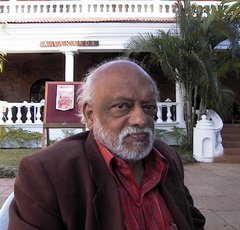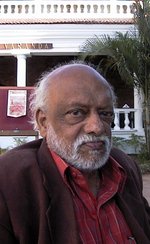Other names
Francis Newton Souza
Place of birth
Date of arrival to Britain
Place of death
Mumbai, India
Date of time spent in Britain
1949–67
About
Francis Newton Souza or F. N. Souza, as he was known, was born in a small Goan village in 1924, which was then Portuguese-ruled. He initially studied and worked in what is now called Mumbai (then, Bombay), eventually helping to establish the Progressive Artists’ Group there. The rise of this radical community of artists coincided with the end of British colonial rule on the Indian subcontinent in 1947 and as such their work reflected the political and cultural change of the new postcolonial world order. The Progressives were experimental by merging styles together, drawing upon traditional South Asian artistic forms to influence emerging modernist trends and European art. Souza himself was known for the disruptive quality of his pieces, as much of his work challenged the authority of political and religious institutions, such as the Catholic Church. Following the first few exhibitions of the Progressive Artists’ Group, which included Souza’s early work, he moved to London in 1949.
In 2002 his obituary called him ‘India’s most important, and famous, modern artist’, yet he was highly influential in the UK as well. He used his art, specifically the medium of self-portraits, to explore the identity of post-war migrants, sometimes in response to racial tensions of the period. Souza was not just an artist but also a writer. It was the publication of his essay ‘Nirvana of a Maggot’ about his experience producing art in Goa that led to a string of solo exhibitions in Gallery One in London and recognition by the famous British art critic John Berger. The 1950s were his most artistically productive decade, and his work derived influence from the political and social contexts in which he was working. Some of his famous works include his oil painting Crucifixion (1959, purchased by the Tate in 1993), and his Self Portrait (1961). Indeed, a few years after his death, Tate Britain acquired some of his collection, making him the first Indian artist to occupy his own room in the gallery. It was also in the 1950s that he met his partner Liselotte de Kristian. Their interracial marriage would produce three children, but would later be broken around the time of his affair with the 17-year-old Barbara Zinkant.
Though Souza offers a particularly prominent example of how individuals from ex-colonies shaped postcolonial society and culture in Britain, he was not the only Indian artist to move to the UK and enter the London art scene in the 1950s. For example, another member of the Progressive Artists’ Group, Sadanand K. Bakre, sculptor and artist, also made the move to London in 1951, contributing to British art just as Souza did in a number of ways.
Souza moved to New York in 1967, a change that also altered his artistic style. He died in 2002 in Mumbai.
Indian independence movement
Words and Lines (London: Scorpion Press, 1959)
‘Biography’, Francis Newton Souza website, http://www.fn-souza.com/
‘Francis Newton Souza (1924–2002)’, National Portrait Gallery website, https://www.npg.org.uk/collections/search/person/mp59783/francis-newton-souza
Gupta, Atreyee, ‘Francis Newton Souza’s Black Paintings: Postwar Transactions in Color’, The Art Bulletin 103.4 (December 2021), pp. 111–37
Klein, Deepanjana and Vesey, Damian, ‘Souza, Francis Victor Newton [known as F. N. Souza]’, Oxford Dictionary of National Biography (Oxford University Press, 2019) [https://doi.org/10.1093/ref:odnb/76997]
Kurtha, Aziz, Francis Newton Souza: Bridging Western and Indian Modern Art (Ahmedabad: Mapin Publishing, 2006).
Nelson, Saul, ‘Writing to Barnett Newman: F. N. Souza and the End of Modernism’, Art History 44.4 (2021), pp. 742–68
Salter, Gregory, Art and Masculinity in Post-war Britain: Reconstructing Home (London: Bloomsbury, 2020)
Wood, Christopher P., ‘F. N. Souza’, Guardian (17 June 2002)
TG 4/9/614/1, Oxford: Museum of Modern Art. Loan of works by various, 31 May 1974 – 25 October 1985, Tate Gallery Archive, London
TG 4/9/476/2, London: South Bank Centre. Includes the Hayward Gallery. Loan of works by various, 29 March 1989 – 2 August 1990, Tate Gallery Archive, London
Banner image credit
Thurston Hopkins/Picture Post/Hulton Archives via Getty Images
Image credit
FN Souza , seen at a hotel in Arpora, Goa, Frederick Noronha, 1 January 2022, CC BY-SA 4.0, https://creativecommons.org/licenses/by-sa/4.0/ via Wikimedia Commons
Entry credit
Ellen Smith


